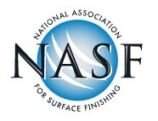The course consists of 10 lessons. Each one contains a wealth of valuable, practical information. And if you score 70 or above on the optional exam, you’ll receive 1 credit toward certification as a Master Surface Finisher. MSF is the world’s most respected – and most widely recognized – designation for finishing industry professionals. Those passing 6 course exams earn the coveted MSF designation.
Course Options
Web-Based
Dates: April 4, 5, 11, 12, 18, 19, 25, 26
Registration Deadline: March 21, 2023
Member: $975 | Non-Member: $1,300Home-Study
Member: $900 | Non-member: $1,300
Optional Exam
Member: $200| Non-member: $300
Who Benefits
This training program is beneficial for operators and supervisors of job shops and captive shops performing hard chromium plating operations on a variety of substrates. The course can also benefit sales personnel who work for suppliers of hard chromium, and equipment.
At the conclusion of this course, attendees can expect to:
- Have a basic understanding of chemical and electrical principles as they relate to hard chromium plating.
- Be able to apply Faraday’s law in calculating the time required to obtain a target thickness of chromium plate.
- Be aware of methods for reducing contamination from the plating process.
- Know the types of analytical procedures employed to monitor the hard chromium plating process.
- Be able to identify the causes of common plating related problems and their solutions.
- Be prepared to take the examination which is part of the Foundation MSF Certification Program.
Course Description
- 1. Chemistry for Hard Chromium Platers
- This lesson covers the basic chemistry principles needed to better understand the plating process. The lesson begins with the structure of an atom and builds upon that basic information to yield an understanding of chemical reactions as they may be employed to process parts for plating, the plating process itself, and post-plating processes as well.
- 2. Electricity for Hard Chromium Platers
- This lesson discusses basic principles in electricity, beginning with Ohm’s Law. Basic rectification principles, how ammeters and voltmeters work, and how current is distributed over a part are important concepts delivered by this lesson. A special focus is given to the use of shields, robbers, bipolar anodes and auxiliary anodes as a means of more evenly distributing current.
- 3. Electrochemistry for Hard Chromium Platers
- This lesson begins with Faraday’s Law and shows how it can be used to predict plating time. The lesson then goes on to the Electromotive Force Series, how the corrosion behavior of metals can be predicted, and how the EMF series can explain processes such as zincating of aluminum prior to chromium plating. The concepts of polarization in plating and factors affecting deposit structure are also covered.
- 4. Equipment for Hard Chromium Plating
- This lesson provides information on the equipment used for hard chromium plating, including tanks, bus bars, racks, rectifiers, agitation systems, process heating/ cooling and anodes. A special focus is placed on anode condition and maintenance, along with proper ventilation practices and emission controls.
- 5. Masking Techniques
- This lesson covers the various methods employed to selectively plate chromium. Masking methods such as stop-off lacquer, waxes, tapes, permanent masks, and high temperature melts and solvent-based commercial dip maskants are described and discussed, along with the advantages and disadvantages of each. A brief discussion on use of conforming anode-mask combinations and out-of-tank plating as a way to minimize masking is also provided.
- 6. Mechanical Surface Preparation
- This lesson covers physical methods used to prepare a surface for plating, including wet and dry blasting, grinding, polishing, shot peening, and honing. A brief discussion on methods used to repair damaged surfaces prior to plating (dot welding, heavy nickel build-up) is also provided.
- 7. Chemical Surface Preparation
- This lesson covers the chemical methods used to prepare a surface for plating, including the role of alkaline cleaners, zincating of aluminum, and reverse etching methods of various metallic substrates, such as copper, steel, tool steel, stainless steel, electroless nickel, parts that have been chromium plated, and cast iron.
- 8. Basic Chromium Plating Principles
This lesson discusses the three major types of hard chromium plating processes (conventional, fluoride and non-fluoride mixed catalyst baths).
Chemical make-up and operational conditions for each process are provided. The lesson also focuses on the mechanism of deposition of hard chromium and how various structures are obtained (thin-dense, for example). Another special focus is hydrogen embrittlement, its causes and cures.
- 9. Analysis & Control of Chromium Plating Solutions
- This lesson will provide guidance on analytical procedures that are used to determine the concentration of the main ingredients and impurities in hard chromium plating solutions. It also shows how to calculate chemical additions to the process and how surface tension can be measured. Another focus is Hull Cell testing and hardness measurement.
- 10. Troubleshooting & Purification of Chromium Plating Solutions
- This lesson describes the most common hard chromium plating defects, their potential causes and possible solutions.
